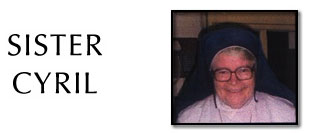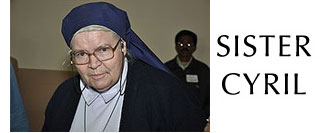A Woman For Her Time
By Stan and Moya Mac Eoin
The authors, husband and wife, are retired teachers who live in Kinvara, County Galway, Ireland, on the southern side of the famed Galway Bay. Stan has been a lifelong friend of your editor since they became classmates in O’Connell Schools, Dublin, in Grade Three. One of the schools in Dublin that sends students to help in Kolkata, Stanhope Street, is where your editor spent four years in the Boys’ Kindergarten.
After a six week boat journey, the 18-year-old postulant never expected to see her family or native country again. But like many others before her, and others with her on that journey, she accepted it as God’s will for her. She would fulfil her vocation as a Loreto Sister teaching the daughters of professionals and civil servants, army officers and high ranking policemen in India, and also engage in some charitable work to help alleviate the suffering of the myriads of poverty-stricken people in the teeming cities.
 After completing her novitiate, qualifying as a teacher and gaining a doctorate in science from Lucknow University, Sr Cyril Mooney was assigned to the prestigious Loreto Convent School in Sealdah, Calcutta, now known as Kolkata, as its principal. She ran a very good school, with its primary and secondary components, and many of its pupils won awards for their excellence in a range of subjects.
After completing her novitiate, qualifying as a teacher and gaining a doctorate in science from Lucknow University, Sr Cyril Mooney was assigned to the prestigious Loreto Convent School in Sealdah, Calcutta, now known as Kolkata, as its principal. She ran a very good school, with its primary and secondary components, and many of its pupils won awards for their excellence in a range of subjects.
Sister Cyril lived in Entally Convent, a few kilometers from the Sealdah school. Every day she saw the many families living on the pavements and in the slums as she made the journey between convent and school. She began to question where her priorities as an educator and missionary should lie. Did she have to choose between running a very good school and helping the poorest of the poor? Before her, Mother Teresa had received episcopal permission to leave the Loreto Sisters and to establish the Missionaries of Charity to bring comfort and solace to the poorest, the marginalized, the disabled, orphans and lepers in the aftermath of the British-engineered horrific famine of 1943 in which two to three million in Kolkata died of starvation (food and the means of transporting it were destroyed as part of a wartime effort to halt the Japanese advance).
Sister Cyril’s reflections brought her to the conclusion that the only way to raise the poorest out of their wretched condition was to provide their children with food and education. Coming from Ireland, she would have remembered the teaching of Thomas Davis, ‘Educate that you may be free’. But even more than that she was conscious of the command of Jesus Christ, ‘Suffer the Little Children to come unto me’. But how could children fulfil their destiny living in what some would describe as hellish conditions in their rat-infested hovels or pavement sleeping sites? Sister Cyril became aware of young girls being kidnapped for evil purposes, of children being molested and raped. She had to do something to change the situation. Nothing less than a revolution was needed.
Moya, Stan and two young Sealdah friends
The solution was to invite the poor girls from the streets and slums to come to her school to be educated and fed, and given sleeping accommodation if that was necessary. But how were the largely middle-class parents of the fee-paying pupils going to react to an influx of ragged, illiterate girls in their prestigious school? This had to be faced and the authorities in her congregation had to be convinced that what she was doing was right.
The obstacles were overcome and over time a system for integrating poor girls into the school was devised. This involved providing accommodation on the flat roof of the school for up to 300 girls. The fee-paying students were enlisted to help, on a one-to-one basis, in bringing the newcomers up to an educational standard where they could be placed in a class suitable to their age. Children who came at an early age were, in time, placed in a class in Loreto Sealdah, which is an English-medium school. Older Bengali-speaking girls were placed in a Bengali-medium state school, but they lived and were given their meals in Loreto Sealdah.
Sister Cyril called her new mission the ‘Rainbow Project’, because after the rain the rainbow brings sunshine and happiness. The students are proud to call themselves the ‘Rainbow Children’. Soon Sisters in other Loreto schools followed Sister Cyril’s example and now thousands of girls have been saved from poverty and degradation and have been put on the road to emancipation, fulfilment and independence.
'A Dublin High School student says goodbye to his pupils after classes at Tengra Refuse Site, Kolkata (Calcutta)
A Drop in the Ocean
Even though the Rainbow Project spread to other areas in Kolkata, in India and further afield, Sister Cyril realized that there were still thousands of boys and girls with no access to education. With the support of UNICEF, the West Bengal government,(which met the cost of classroom materials, and a number of NGOs, she established a scheme to train teachers in a crash programme over a twelve month period. The trainees are drawn from motivated but unemployed young men and women who had stayed at school themselves up to about 15 years of age. These teachers then go back to their own areas and conduct classes. They and the children are continuously evaluated and supported. Up to 500 of these ‘schools’ are now being run throughout the city, and in its outskirts, and they have a combined enrolment of approximately 30,000.
But Loreto Sealdah has also promoted the raising of educational standards throughout the whole educational system not only in Kolkata, but in making its expertise accessible to principals and teachers throughout India. ‘School transformation’ is the goal and courses in curriculum content, methodology and human rights education are regularly held. The writers of this article were privileged to reinforce the training received by teachers from Silchar, in Assam, when they were invited by Fathers Jose and Anthony, Salesian priests who built a new English-medium school there, to help prepare the teachers before the school opened and in a subsequent year to help monitor their performance and to assist with vocational and adult education courses.
Moya, right, with primary school teachers in Assam.
Forever Reaching Out
Wherever there is a need perceived and Sister Cyril and her supporters have
the capability and means to meet the need, they have always done so. This
includes ‘Childline’ where older Rainbow children help operate a free dedicated
Kolkata-wide telephone help-line for children in distress. If necessary, the
school transport can then be used to rescue a child caller.
The Rainbow Children are also committed to distributing food to the destitute
every day, mostly at the nearby huge Sealdah Railway station. However, the
railway authorities now want this to be stopped as they feel that the
distribution of food is drawing the destitute to their station. At present,
there is on-going dialogue on the issue, as the authorities recognise the
motivation behind the scheme. A home, Balobasha (House of Love), has been set
up, with the help and support of Irish benefactors, as a permanent residence for
some of the older destitute women.
An effort is made to help the parents of the Rainbow and non-fee paying children become more self-sufficient and independent. Medical facilities are provided at the school and the parents are helped to develop skills that will help them earn a livelihood. Women (mostly) have established vegetable stalls, made handcrafts and saris and set up other worthwhile enterprises through finance obtained through a micro-credit project that has been supported by the Irish League of Credit Unions.
A Micro-credit meeting in Sealdah, Calcutta
Through cooperation with another NGO, girls who have been rescued from trafficking (mostly for slave labor in homes, but some for prostitution purposes also) have been welcomed in Loreto Sealdah where they receive education, or go to a nearby Bengali-medium state school from there.
In the past year Sister Cyril has reached out to the children of migratory workers in the ‘Brick Fields’. Families travel long distances to find work in the brick fields and as the payment is based on piece work, long hours are worked and all the members of the family who can do so help make the bricks. Sister Cyril succeeded in getting the cooperation of some owners to facilitate her in setting up classes for a few hours in the evening for children who would otherwise go through life with no education at all.
She also had schools established on the outskirts of the city in an effort to discourage young men and women from coming in to the city with its huge unemployment, poverty, lack of accommodation, exploitation and vice.
Recognition
 Over the last number of years Sister Cyril’s work has been recognised within
India and abroad, especially in Ireland. She has been honored by the Government
of India in being awarded the Padma Shree, the highest honor that can be
bestowed on a non-citizen of India. The Irish government has acknowledged her
work and she will receive an honorary degree from Trinity College, Dublin, this
year.
Over the last number of years Sister Cyril’s work has been recognised within
India and abroad, especially in Ireland. She has been honored by the Government
of India in being awarded the Padma Shree, the highest honor that can be
bestowed on a non-citizen of India. The Irish government has acknowledged her
work and she will receive an honorary degree from Trinity College, Dublin, this
year.
Students from a number of schools, including Duns Scotus (a mixed school), Belvedere College (boys) and Stanhope Street (girls) in Dublin, spend a number of weeks every year helping in Loreto Seladah and with other projects in Calcutta and its hinterland. Many young teachers and other young people, as well as some retired adults, mostly from Ireland and Australia, but also from a range of other countries including Iceland, Norway, Spain and Japan, offer their services to Sister Cyril to help teach and socialize with the Rainbow Children.
Stan with Sister Cyril
The writers of the article feel privileged to have had the opportunity to participate in the work being done in Loreto Sealdah. They have helped Rainbow Children with their homework and got to know some of them very well. They have seen young girls grow from typical young teenagers to sophisticated, caring students, graduates and employees. They have adopted the values imbued in them by Sister Cyril and her colleagues and they have remained steadfast to the values of their faith, whether that be Hindu, Muslim or Christian. They have a tolerance and respect for diversity that is a template for all young students everywhere.
Thank you, Sister Cyril, for giving us the opportunity to be part of your work.
You may contact the authors at stanmaceoin@yahoo.com